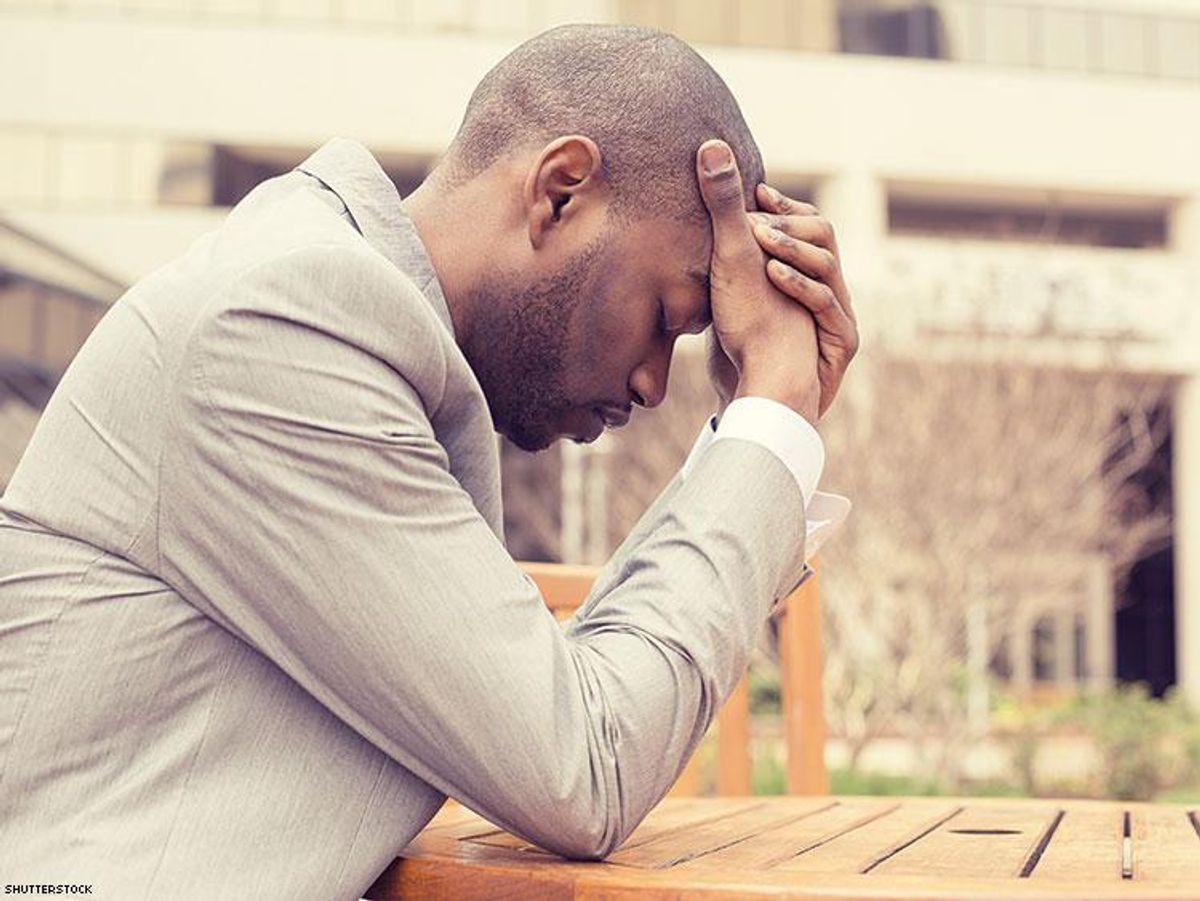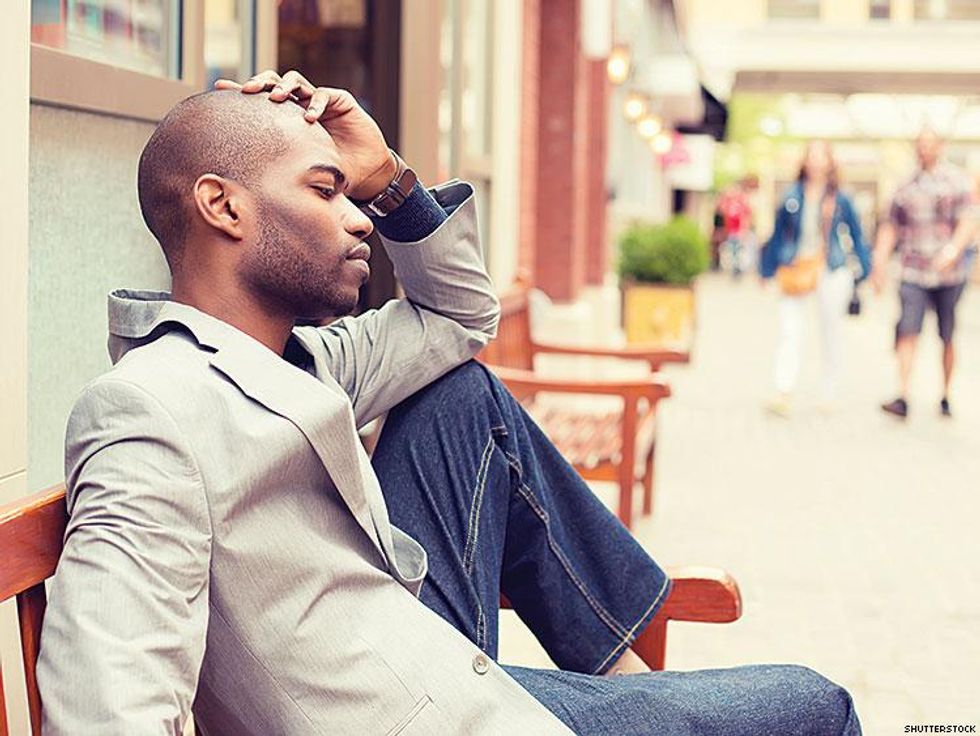Current Issue
Let’s Stop Shaming Black Men

Fifty percent of black gay men may become HIV-positive in their lifetime, but the cause is not what you think.
February 28 2017 6:32 AM EST
May 26 2023 2:10 PM EST
By continuing to use our site, you agree to our Private Policy and Terms of Use.

Fifty percent of black gay men may become HIV-positive in their lifetime, but the cause is not what you think.
Last February, the Centers for Disease Control and Prevention released a report predicting that, if things don't change, one out of every two gay or bi black men will become HIV-positive in their lifetime. This statistic has been repeated endlessly, usually in connection with reasons why HIV rates are higher among African-American men who have sex with men. To be fair, there are a wide range of factors that play a part in raising HIV risks, including poverty, drug use, childhood sexual assault, and depression.
"We cannot separate the high infection rates among black gay men from several ills that continue to plague our society," Greg Millet wrote for The Advocate in 2015. "Discrimination, poverty, stigma, and lack of access to health care all affect health care utilization for black gay men. As a result, a substantial proportion of black gay men remain undiagnosed, and others who are diagnosed and without the financial means to access medications will remain virally unsuppressed."
Many of these factors also impact heterosexual black men, so what's at the root of the disproportionate HIV rates for their queer brothers? One prevalent argument is that -- because of excessive homophobia in the black community -- black gay and bisexual men have low self-esteem. That lower self-esteem leads them to be more promiscuous, engage in riskier sexual behaviors, and even use drugs; which explains why HIV rates among black men who have sex with men is so high. Makes sense? Problem is, it's also wrong.
The difficulty with this breakdown of causality is that it's based on faulty premises, which many people -- including leaders in the LGBT and HIV communities -- keep sharing, over and over again.
"Contrary to what was presumed," Millet wrote, "multiple studies have shown that black gay men are less likely to have condomless sex than white gay men and far less likely to use drugs like poppers or crystal methamphetamine during sex, which heighten the risk of HIV infection."
"Greg Millett has done some really fascinating work about all these potential differences by race," says Neal Goldstein, Ph.D., MBI, who has studied sexual behavior and the use of drugs among gay men, as well as HIV disparities. Goldstein is an infectious disease epidemiologist at Delaware's Christiana Care Health System and he teaches at the Dornsife School of Public Health at Drexel University in Philadelphia.
"Do we see this increase in risk among black [men who have sex with men] compared to white MSM because they are more promiscuous?" Goldstein asks rhetorically. "No. In fact, based on the work by Millett's group, you see that black MSM have even fewer partners than white MSM, so there is something else out there explaining the risk."
Published in the Lancet, Millett's 2012 meta-analysis of nearly 200 studies also found that black men who have sex with men were only as likely to have "serodiscordant unprotected sex" as other MSM. In other words, black gay and bi men were not more likely to have anal sex without a condom with someone they believed to be of a different HIV status.
A CDC study presented at the 2016 International AIDS Conference analyzed "sexual risk behaviors" among male high school students. Risk behaviors included having sex without a condom or having multiple sexual partners. The study, found "no significant differences" in the HIV-related risk behaviors of gay, bisexual, or heterosexual self-identified male youth.
Despite the fact that boys of all sexual orientations share similar HIV-related risk behaviors, the rate of HIV transmissions is much higher among young men who have sex with men. In 2014, for example, gay and bisexual males represented 80 percent of new youth infections.
The reason straight boys have lower risks of HIV? Although the study didn't include different sexual positions as risk factors, Dr. Laura Kann, chief of CDC's School-Based Surveillance Branch, speculated afterward that "the transmission risk for receptive anal sex is 17 times higher than [for] vaginal sex." Teen boys who are only having insertive sex with their partners (be they male or female) have a significantly lower risk than boys who are on the receiving end of anal sex. (The same can be projected for transgender women and girls who have sex with gay or bi men.)
So, if studies have shown that African-American gay and bi men don't engage in riskier sexual behavior what is to blame? Smaller social circles. Millet argues that because HIV rates are higher among black men, gay and bi black men are more likely to date someone who is HIV-positive. He points to a study that "found that white gay men in Atlanta needed to meet seven sex partners to have a 50 percent probability of meeting an HIV-positive partner, whereas black gay men needed only 3.5 sex partners."
Goldstein agrees, explaining that the "social sexual networks" of black gay and bisexual men are likely to blame.

"If you are a black man, [race] may effect the size of the potential number of other men that you could have sex with, that you would engage with in social context, and then you would further go on to have sex with. If your pool of men is smaller, then it's a lot easier for HIV to move around in that smaller pool. You may not be having more sex--and you may even be having less sex -- [but] because you have a much smaller pool of available men to have sex with, it makes [contracting]HIV a lot easier."
The impact of those smaller dating pools is compounded by racism. As The New York Times previously reported, at one popular dating site, 80 percent of contacts initiated by white members were connections with other white members. Only 3 percent of contacts initiated by white members were with black members.
The influence of social sexual networks also intensifies over time. Since the early days of the AIDS epidemic, gay and bisexual men have had higher rates of HIV than straight men. Men who have sex with men are in the minority, so every case of HIV impacts their community differently than one case in the straight dating pool. Add to that the fact that vaginal sex has a lower risk of transmitting HIV than anal sex -- for a variety of reasons -- and the rates of HIV among gay and bi men continue to outpace those of straight men.
Some of Goldstein's research (published in the journal Epidemiology) takes into account whether disparities between groups are "real" or if they are hiding other influences, such as a tendency to underreport things that are socially stigmatized. For example, Goldstein says, "If you are black or African-American, you face more stigma in your community for disclosing that you are MSM. We thought, well maybe this is a prime reason why we see these divergent estimates in HIV risk."
In fact, many studies rely entirely on the self-identification of risk factors and sexual orientation. But Goldstein's research team wanted to account for those whose sexual identity doesn't reflect their behavior. He points out that the risk for a gay man who receives oral sex, is significantly different from a straight-identified man who is the receptive partner in anal intercourse with another man.
In addition to "accounting for how risk is assessed," Goldstein says his team also established who that risk is being compared to. Comparing black gay and bi men with straight black men, they found something surprising: the disparity between straight white men and white MSM is larger than the HIV disparity between black straight men and black MSM. This is, Goldstein simplifies, because the black community as a whole has higher rates of HIV than the white community.
Just as there's this misconception that gay and bi black men have riskier sex, there's a similar stigmatizing mythology around drug use. Increased drug use does play a part in compounding risks among gay and bisexual men of all races. The CDC found gay and bi men were five times as likely to try injection drugs (10 percent reported trying them). But, black gay and bisexual men have repeatedly been shown to be less likely than white MSM to have a history of substance use.
Last year, International Journal of Drug Policy published Goldstein's report evaluating usage of drugs among racial and sexual minorities.
"When we examine drug use as a whole according to race it can be misleading," Goldstein says now. "Which is why in our report in IJDP we further decomposed the data by sexual behavior, which I'm not sure anyone had done [up to] that point in a nationally representative sample. Thus, our comparisons are between racial groups with respect to sexual identity. For example, it's not that white men are more likely to use amphetamines, compared to black men; it's that white gay men are more likely to use them compared to black gay men."
Goldstein maintains that the disparities between black gay men and white gay men lower dramatically when all factors are accounted for, including intersecting and compounding issues like racism, homophobia, and poverty.
"We've done as good of a job as we can in accounting for how information is measured in surveys -- whether it is sexual behavior information, whether it's drug use behavior information -- and we've accounted that really to the extent that we can go," Goldstein acknowledges.
But, even after factoring in all "these underlying risk differences between the groups," Goldstein adds, "there really is something different between the racial groups, that we posit is related to the concept of a social sexual network."
But, the questions remain: How do we prove that? How do we solve that? Nobody knows, but that won't deter researchers like Goldstein.
"Overall, that's where we're at," he says of the social sexual network theory. "Unfortunately we just don't have good data on those because that is very hard to ascertain."
Viral post saying Republicans 'have two daddies now' has MAGA hot and bothered